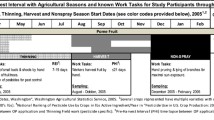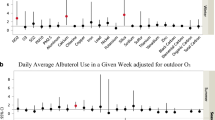Abstract
The Non-Occupational Pesticide Exposure Study, funded by the U.S. Environmental Protection Agency, was designed to assess total human exposures to 32 pesticides and pesticide degradation products in the non-occupational environment; however, the study focused primarily on inhalation exposures. Two sites—Jacksonville, Florida (USA) and Springfield/Chicopee, Massachusetts (USA)—were studied during three seasons: Summer 1986 (Jacksonville only), Spring 1987, and Winter 1988. Probability samples of 49 to 72 persons participated in individual site/seasons. The primary environmental monitoring consisted of 24-hr indoor, personal, and outdoor air samples analyzed by gas chromtography/mass spectrometry and gas chromatography/electron capture detection. Indoor and personal air concentrations tended to be higher in Jacksonville than in Springfield/Chicopee. Concentrations tended to be highest in summer, lower in spring, and lowest in winter. Indoor and personal air concentrations were generally comparable and were usually much higher than outdoor air concentrations. Inhalation exposure exceeded dietary exposure for cyclodiene termiticides and for pesticides used mainly in the home. Dietary exposures were greater for many of the other pesticides. Inhalation risks were uncertain for termiticides (depending on rates of degradation) but were negligible for other pesticides. The data were insufficient to support risk assessments for food, dermal contact, or house dust exposures.
Similar content being viewed by others
References
Annual Book of ASTM Standards 11.03 (1991a) Standard practice for sampling and analysis of pesticides and polychlorinated biphenyls in indoor atmospheres (D4861-91), American Society for Testing and Materials, Philadelphia, pp 348–361
-- (1991b) Standard test method for chlordane and heptachlor residues in indoor air (D4947-89), ASTM, Philadelphia, pp 366–372
Cox BG, Mage DT, Immerman FW (1988) Sample design considerations for indoor air exposure surveys. J Air Poll Contr Assoc 38:1266–1270
Hsu JP, Wheeler HG, Camann DE, Schattenberg HJ, Lewis RG, Bond AE (1988) Analytical methods for detection of nonoccupational exposures to pesticides. J Chromatogr Sci 26:181–189
Kalton G, Maligalig DS (1991) A comparison of methods of weighting adjustment for nonresponse. Bureau of the Census 1991 Annual Research Conference Proceedings, pp 409–428
Kish L (1965) Survey sampling. Wiley, NY
Lewis RG, Bond AE, Fortman RC, Camann DE (1994) Evaluation of methods for monitoring the exposure of small children to pesticides in the residential environment. Arch Environ Contam Toxicol 26:37–46
Lewis RG, Bond AE, Johnson DE, Hsu JP (1988) Measurement of atmospheric concentrations of common household pesticides: a pilot study. Environ Monit Assess 10:59–73
Lewis RG, MacLeod KE (1982) A portable sampler for pesticides and semi-volatile industrial organic chemicals. Anal Chem 54:310–315
Lewis RG, Lee RE Jr (1976) Air pollution from pesticides: sources, occurrences and dispersion. In: Lee RE Jr (ed) Air pollution from pesticides and agricultural processes. CRC Press, Boca Raton, FL, pp 5–55
Nigg HH, Beier RC, Carter O, Chaisson C, Franklin C, Lavy T, Lewis RG, Lombardo P, McCarthy JF, Maddy KT, Moses M, Norris D, Peck C, Skinner K, Tardiff RG (1990) Exposure to pesticides. In: Baker SR, Wilkinson CS (eds) The effect of pesticides on human health: advances in modern environmental toxicology, Vol XVII. Princeton Scientific, NY, pp 35–130
Roberts JW, Budd WT, Ruby MG, Bond AE, Lewis RG, Wiener RW, Camann DE (1991) Development and field testing of a high volume sampler for pesticides and toxics in dust. J Exp Anal Environ Epidem 1:143–155
Wallace LA (1987) The total exposure assessment methodology (TEAM) study: Summary and analysis: Volume I(EPA/600/6–87/002a). Office of Research and Development, U.S. Environmental Protection Agency, Washington, DC
US Bureau of the Census (1983a) Statistical abstract of the United States: 1983. US Government Printing Office, Washington, DC
— (1983b) County and city data book, 1983. US Government Printing Office, Washington, DC
Author information
Authors and Affiliations
Rights and permissions
About this article
Cite this article
Whitmore, R.W., Immerman, F.W., Camann, D.E. et al. Non-occupational exposures to pesticides for residents of two U.S. cities. Arch. Environ. Contam. Toxicol. 26, 47–59 (1994). https://doi.org/10.1007/BF00212793
Received:
Revised:
Issue Date:
DOI: https://doi.org/10.1007/BF00212793




